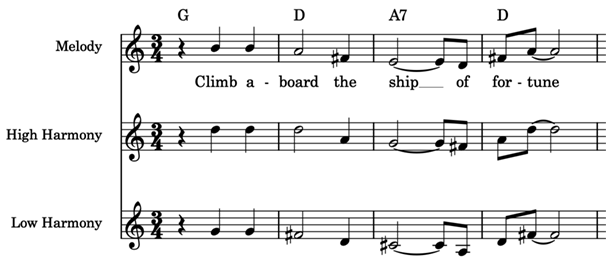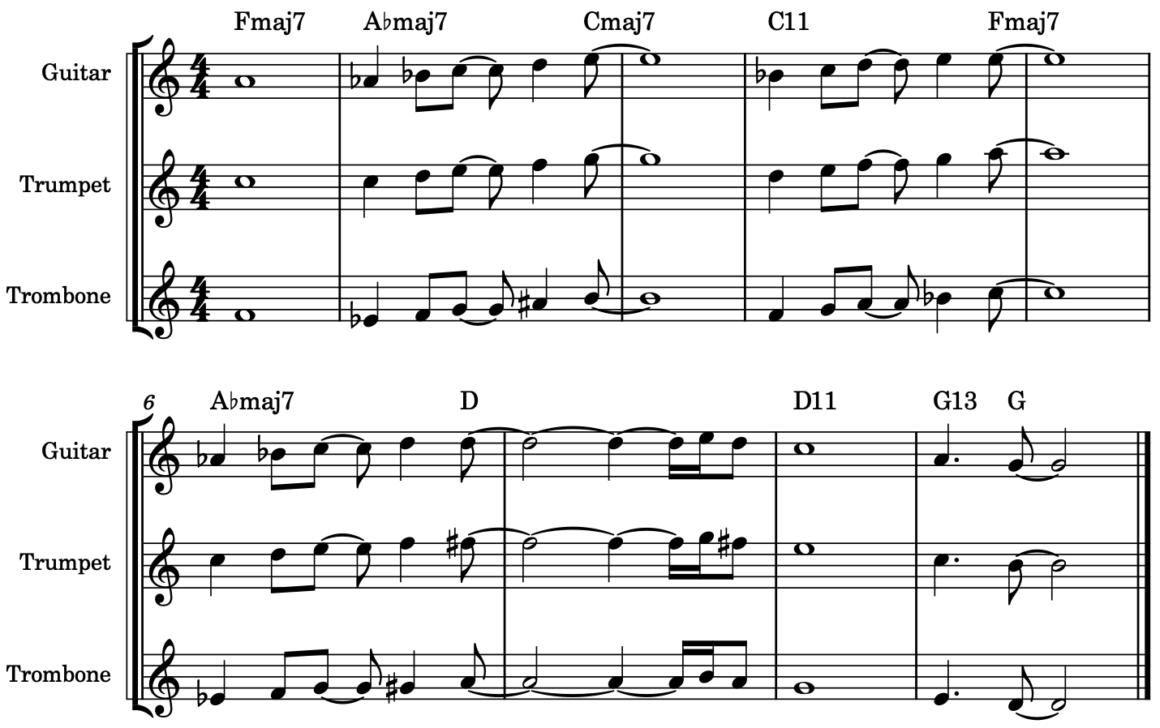Let’s go on a sentimental journey …
Thanks to howtosingsmarter.com for a fine example of three-part harmony singing.
We get to hear two-part harmony in most music, typically a second voice or instrument a third (two notes in the scale) above the melody. It might only appear in a chorus, or perhaps with backing vocals or horn parts but it will be there somewhere. A two-part harmony is not difficult to write and can often be worked out by trial and error.
When we extend the harmony to three parts, it gets trickier to organise. When you sing or play any three notes in harmony you obtain a chord and yet your melody and two harmony lines will usually sit over an existing chord progression. You need to organise your harmonies so they don’t obfuscate the melody, are singable/playable and don’t clash with the underlying chords in any unpleasant way. That takes some thought.
My five rules
- Position the two harmony parts appropriately: Normally one will go above and one below the melody. If the melody is low, you might position both above. If the melody is high, you might position both below. Of course, you may be constrained by the vocal ranges of the singers. Normally you’ll keep the three parts tightly together with no more than an octave from top to bottom.
- Don’t swamp the melody: The melody should have the greatest intensity/volume/presence of the three parts. Generally, higher notes stand out more, so if you have a high harmony that is too prominent, bring it down in the mix and/or drop it back with reverb/echo. You’re also likely to have the main melody in the centre of the stereo spread, with the two harmonies positioned on either side.
- Follow the pattern of the melody: Typically, your harmony parts will move up or down with the melody along the same scale but this won’t always be possible because of point 4 below.
- Hit the notes of the underlying chords: On the strong beats, when chords are likely to change or be re-emphasised, have the harmony parts stick to notes from the chord. Sometimes this might mean that one of the parts can’t follow the pattern of the melody exactly – maybe staying on the same note.
- Don’t overdo it: Three-part harmony has a dramatic impact. If you were writing for a band that specialises in harmonies, or perhaps a choir or barbershop quartet, then OK, go for it. But most music needs variation in texture and intensity, so I’d keep three parts for the chorus or a special interlude (think Bohemian Rhapsody!).
Here’s a simple example of three-part harmony on the chorus of a song. The first harmony sits a third above the melody and the second a third below. With a simple, repeated, chord progression of G D A7 D, none of the three vocal parts needs to leave the D major scale:
Here’s how that looks in notation:

Next, here’s a quick example of how multi-layered voices can be used to create an interesting bridge in what is otherwise a song with no harmonies. The voices play the notes of D major and E major chords over a sustained E bass:
Guitars can do three-part harmony too. In the following short excerpt from a prog-rock piece called Goodbye Heart, the acoustic guitar opens playing a riff over the chords Em C B D B7 Em. Then an electric guitar comes in playing the same melody, followed by two more electric guitars in harmony with this:
Getting the harmonies right can be a tussle. Here’s a track, called Just Drifting which, in the chorus, employs a three-part harmony across multiple instruments. An electric guitar plays the main melody; the trumpet plays a third above that (but dropped an octave) and the trombone a third below the guitar, again dropped an octave. The chords in the chorus are rich, with multiple modulations (temporary key shifts from the home key of G major):
Fmaj7 Abmaj7 / Cmaj7 C11 / Fmaj7 Abmaj7 / D D11 / G13 G
The harmony lines had to be finely judged to fit with the chords and some chords were extended to 11ths and 13ths because the harmony sounded right that way and that’s what really matters:
In case you’re interested, here’s the notation:

Of course, it’s now possible to use plug-ins to automatically create harmony parts for a melody line. As long as you are happy with all the parts coming from the same singer, this would work well with the Ship of Fortune example above, but couldn’t cope with the complex chord structure of Just Drifting. In the end, nothing beats knowing how to work it out for yourself.












2 comments
Thank you. I also assume that the audience’s ear will “fill in the blanks” when a chord’s 5th , or sometimes 3rd, is briefly missing.
And, what about SUSPENDED chords?
Again, thank you from a 78-Y-O former MusEd student at NTSU. p.s : I still have my Elementary and Advanced Harmony books from college by Dr Robert Ottman.
You’re right that the 5th is the least likely harmony for you to drop. If you leave out the third then you’re failing to identify the chord as a major or a minor but this would work fine in genres like blues where the major/minor element is often left ambiguous. As for suspensions, they can be highly effective – see my post Suspended Delights – https://instrumentality.me/magic/suspended-delights/